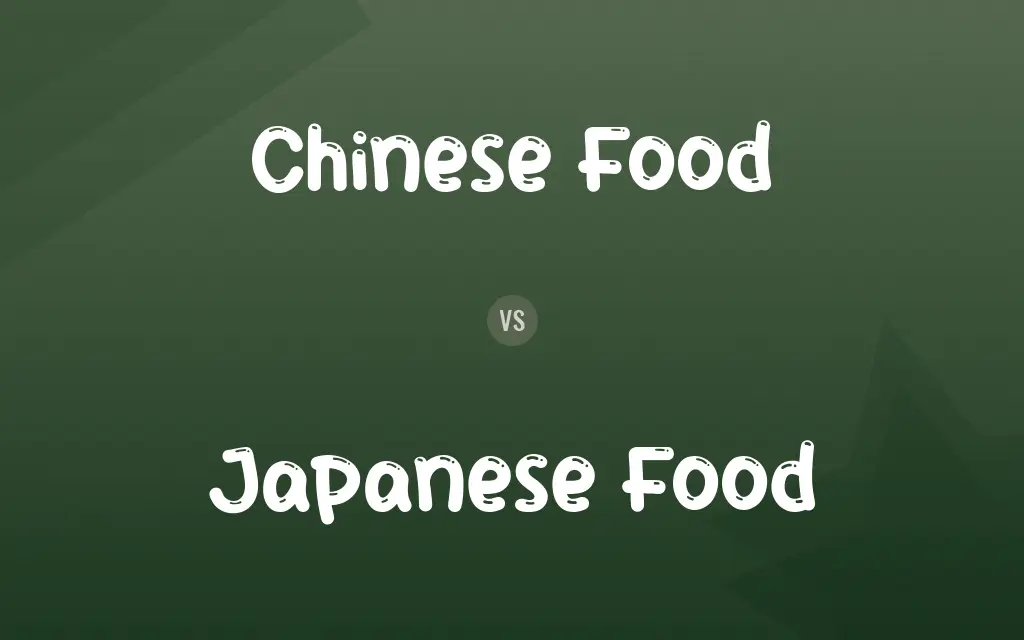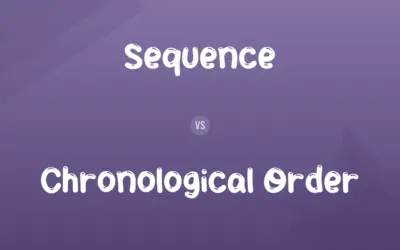Chinese Food vs. Japanese Food: Difference and Comparison
Edited by Muazma Batool — By Muneeza Rehman — Published on April 22, 2024
Chinese food is known for its diverse flavors and regional varieties, emphasizing stir-fries, noodles, and rice dishes. Japanese food focuses on fresh, seasonal ingredients with an emphasis on seafood, rice, and meticulous presentation.

Difference Between Chinese Food and Japanese Food
Chinese cuisine is vast and varied, with eight major culinary traditions reflecting the country's diverse regions, from Sichuan's spicy heat to Canton's sweet and savory. Japanese cuisine, or "washoku," emphasizes seasonal ingredients, simplicity, and balance, often showcasing the natural flavors of seafood, vegetables, and rice. While both value rice as a staple, Chinese dishes often incorporate it into hearty meals or fried rice variations, whereas Japanese meals treat rice as a distinct, subtly seasoned element, sometimes in the form of sushi or onigiri.
Muneeza Rehman
Apr 22, 2024
Chinese cooking methods are diverse, including stir-frying, steaming, and braising, often using strong flavors and a variety of sauces. Japanese cuisine favors more delicate techniques like steaming, boiling, and raw preparations, focusing on umami-rich but less overpowering seasonings such as soy sauce and miso. Presentation is key in Japanese food, where dishes are served in a manner that highlights aesthetic appeal, seasonal themes, and harmony, contrasting with Chinese dishes that might prioritize flavor and abundance over presentation.
Muazma Batool
Apr 22, 2024
Chinese food makes extensive use of a wide array of meats, including pork, chicken, and beef, Japanese cuisine has a notable emphasis on seafood, reflecting its island geography. Vegetables play a crucial role in both, but Japanese dishes often feature them more prominently in their natural, lightly seasoned form.
Muneeza Rehman
Apr 22, 2024
Both cuisines enjoy worldwide popularity, they adapt differently to local tastes outside their home countries, with Chinese food often adjusting flavors more significantly than Japanese cuisine, which tends to maintain a consistent emphasis on traditional preparation and presentation.
Henry
Apr 22, 2024
Chinese Food vs. Japanese Food Comparison Chart
Staple Ingredients
Diverse: noodles, rice, vegetables, various meats.
Focus on rice, seafood, seasonal vegetables.
Muneeza Rehman
Apr 22, 2024
Cooking Methods
Stir-frying, steaming, deep-frying.
Steaming, boiling, raw (sushi).
Muneeza Rehman
Apr 22, 2024
Flavor Profile
Bold and diverse: spicy, sweet, sour, umami.
Subtle, emphasizing umami, fresh ingredients.
Muneeza Rehman
Apr 22, 2024
Presentation
Flavor-focused, less emphasis on presentation.
Highly aesthetic, emphasizing harmony and seasonality.
Lucas
Apr 22, 2024
Meat Use
Extensive use of various meats.
Predominantly seafood, with some chicken and pork.
William
Apr 22, 2024
Adaptability
Adapts flavors to local tastes abroad.
Maintains traditional elements more consistently.
William
Apr 22, 2024
Seasoning
Wide use of sauces and spices.
Focus on natural flavors, seasoned with soy sauce, miso.
Jonathan
Apr 22, 2024
Chinese Food vs. Japanese Food Definitions
◉Chinese Food
Peking duck is a famous Chinese dish known for its crispy skin and succulent meat, often served with pancakes and sweet bean sauce.
The Peking duck was carved at the table and served with thin pancakes.
Muneeza Rehman
Feb 21, 2024
◉Japanese Food
Miso soup, a traditional Japanese soup, is made from a stock called dashi and miso paste, often containing tofu and seaweed.
Dinner started with a warm and comforting bowl of miso soup.
Muneeza Rehman
Feb 21, 2024
◉Chinese Food
Dim sum refers to small bite-sized portions of food served in steamer baskets or on small plates.
We enjoyed a variety of dim sum, from steamed buns to shrimp dumplings.
Muneeza Rehman
Feb 21, 2024
◉Japanese Food
Onigiri, or rice balls, are a popular snack or light meal in Japan, often filled with pickled plum, salmon, or tuna.
The salmon onigiri was a delicious and convenient snack.
Muneeza Rehman
Feb 21, 2024
◉Chinese Food
Szechuan cuisine is renowned for its bold flavors, particularly the use of garlic, chili peppers, and Sichuan peppercorns.
The Szechuan beef was delightfully spicy and numbing.
Levi
Feb 21, 2024
◉Japanese Food
Sushi is a Japanese dish consisting of vinegared rice accompanied by a variety of ingredients, primarily seafood.
The sushi platter featured an assortment of nigiri and maki rolls.
Muneeza Rehman
Feb 21, 2024
◉Chinese Food
Fried rice, a staple dish, combines rice with eggs, vegetables, and sometimes meat, showcasing the versatility of rice.
The shrimp fried rice was a flavorful and filling meal.
Muneeza Rehman
Feb 21, 2024
◉Japanese Food
Ramen is a Japanese noodle soup with a rich, flavorful broth, often topped with slices of pork, seaweed, and scallions.
The miso ramen had a deep, umami-rich broth that was incredibly satisfying.
Muneeza Rehman
Feb 21, 2024
◉Chinese Food
Chinese cuisine features a rich palette of flavors, with dishes like Kung Pao chicken showcasing the harmony of spicy, sweet, and sour.
The Kung Pao chicken offers a spicy yet balanced flavor.
Muneeza Rehman
Feb 21, 2024
◉Japanese Food
Tempura refers to seafood or vegetables that have been battered and deep-fried, known for its light, crispy texture.
The shrimp tempura was perfectly crispy without being greasy.
Muneeza Rehman
Feb 21, 2024
Chinese Food vs. Japanese Food Frequently Asked Questions
Are noodles common in both Chinese and Japanese foods?
Noodles are significant in both cuisines but vary in types and preparations. Chinese noodles can be wheat-based or rice-based, served in various ways, while Japanese noodles, such as soba (buckwheat) and udon (wheat), have distinct preparations and broths.
Muneeza Rehman
Apr 22, 2024
What is the main difference between Chinese and Japanese food?
The main difference lies in their flavor profiles, cooking methods, and presentation, with Chinese food being more diverse and bold, and Japanese food focusing on simplicity, seasonal ingredients, and aesthetic presentation.
Muneeza Rehman
Apr 22, 2024
Do both cuisines use soy sauce?
Yes, both Chinese and Japanese cuisines use soy sauce, but Japanese cuisine may use it more subtly as part of its emphasis on enhancing natural flavors without overpowering them.
Muneeza Rehman
Apr 22, 2024
Is rice important in both Chinese and Japanese cuisines?
Yes, rice is a staple in both cuisines, but it's used differently. In Chinese cuisine, it's often cooked with other ingredients, while in Japanese cuisine, it's served plain to complement other dishes, such as in sushi or as a side.
Muneeza Rehman
Apr 22, 2024
Can vegetarians find options in both cuisines?
Yes, both Chinese and Japanese cuisines offer vegetarian options, though they may be more abundant and varied in Chinese cuisine due to the extensive use of vegetables and tofu in many dishes.
Muneeza Rehman
Apr 22, 2024
How does the use of meat differ between Chinese and Japanese cuisine?
Chinese cuisine uses a wide variety of meats, including pork, chicken, and beef, often mixed with vegetables and sauces. Japanese cuisine places a greater emphasis on seafood, reflecting its island geography, though it also includes chicken and pork in some dishes.
Muneeza Rehman
Apr 22, 2024
How do Chinese and Japanese foods adapt when they are served in other countries?
Chinese food often adapts more to local tastes, sometimes significantly altering flavors and ingredients. Japanese food tends to maintain its traditional preparation and presentation more consistently, even abroad.
Kaitlyn
Apr 22, 2024
What role does presentation play in Japanese food compared to Chinese food?
Presentation is crucial in Japanese cuisine, where dishes are carefully arranged to please the eye and reflect seasonal themes. In Chinese cuisine, while presentation is considered, the emphasis is more on flavor and quantity.
Lucas
Apr 22, 2024
What is a common misconception about Chinese food?
A common misconception is that all Chinese food is greasy and heavily seasoned, overlooking the vast diversity and regional subtleties of authentic Chinese cuisine, which includes many fresh, lightly cooked, and healthful options.
Jonathan
Apr 22, 2024
What is a typical Japanese meal?
A typical Japanese meal might include a main dish of fish or meat, a bowl of rice, miso soup, and several side dishes of vegetables or pickles, focusing on balance and seasonality.
Elijah
Apr 22, 2024
Content Creators
Written by
Muneeza RehmanAt Comparisons.wiki, Muneeza skillfully navigates the vast sea of information, ensuring clarity and accuracy as the lead content editor. With a keen eye for detail, she curates every comparison to enlighten and engage readers.
Edited by
Muazma BatoolAs a content editor, Muazma Batool is not just a grammar guru but a creative mastermind who breathes life into every word. With an eagle eye for detail and a passion for storytelling, she transforms bland text into engaging content that captivates audiences and drives results.

































